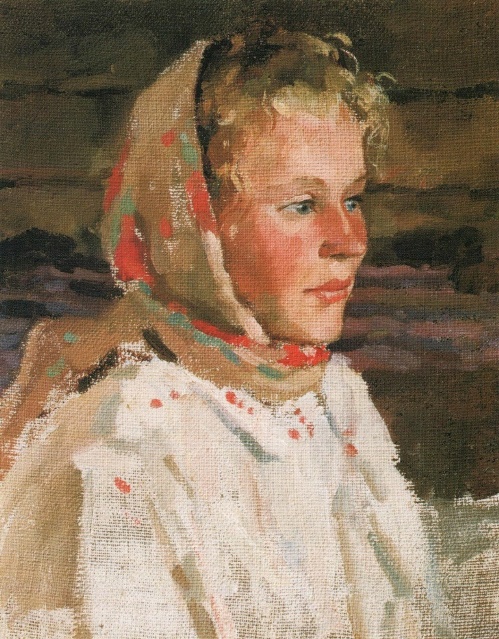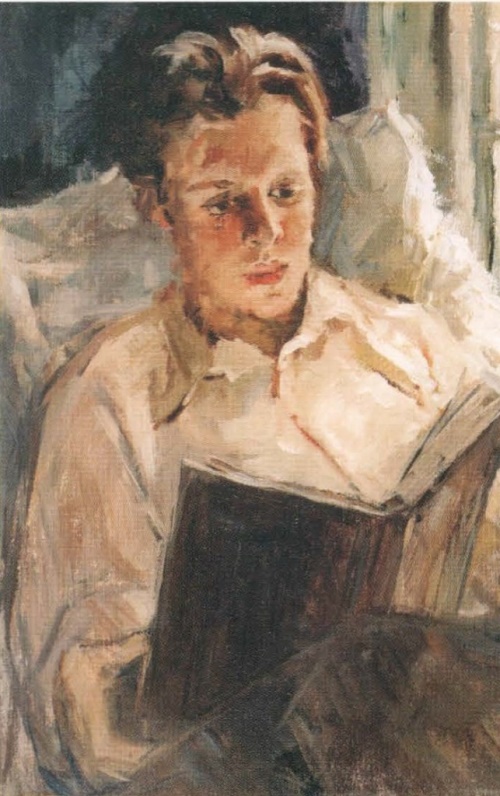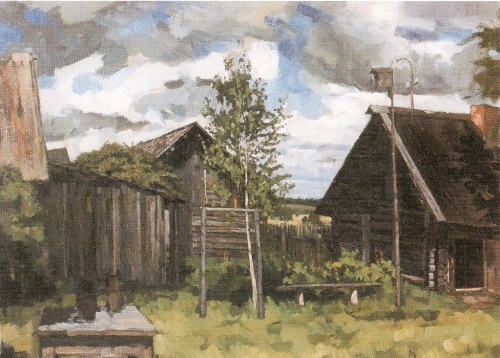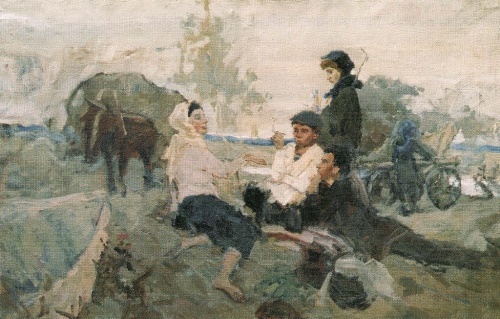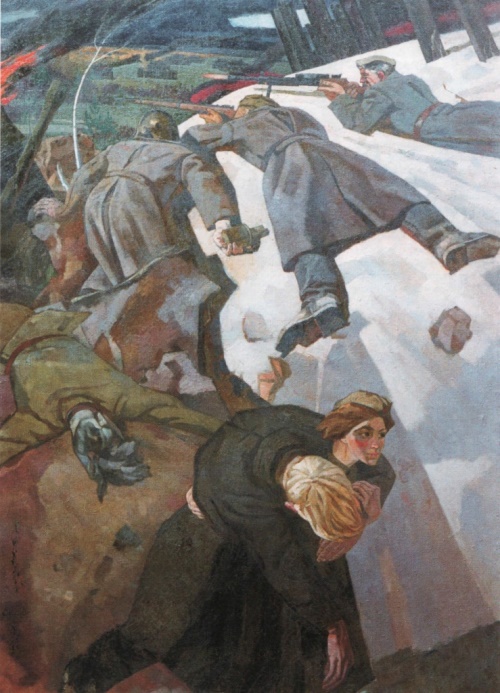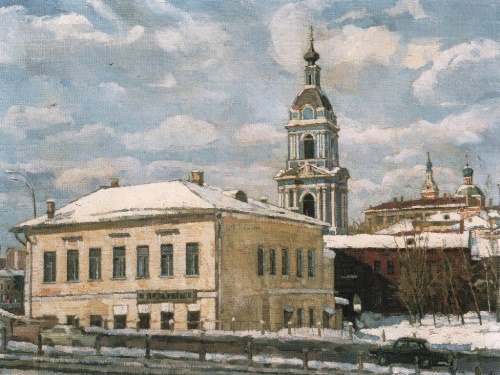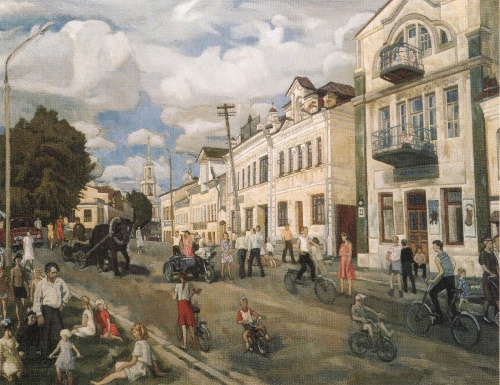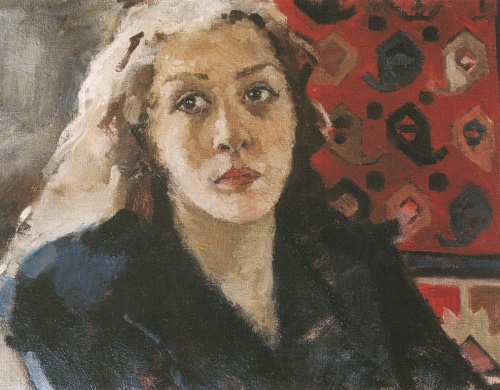Soviet painter Andrei Gorsky 1926-2015

Female portrait. 1954. The State Tretyakov Gallery. Soviet painter Andrei Gorsky (17 April 1926 – 22 September 2015)
Soviet painter Andrei Gorsky (17 April 1926 – 22 September 2015) – member of the USSR Union of artists (1956), Honored Artist of the RSFSR (1982), People’s Artist of the Russian Federation (1996). Andrei Gorsky belongs to the national culture, which determines all his work during the difficult and dangerous for the existence of the Soviet state war and post-war years. Then was laid a solid foundation of his art. The young years of the artist passed in the time of the Great Patriotic War, full of anxiety, both for the fate of each individual soldier, and for the fate of the entire country. And in the soul of a sensitive man, an intellectual grew a sense of patriotism, interest to the history, and love for the motherland. The nature of the Russian North, its courageous people and the historical past of our country, the roots of its culture attracted the artist. Russian history, native environment, the Soviet people, defending the right to live with our heads held high – that unified in its diversity the theme of the artist.

Soviet painter Andrei Gorsky (17 April 1926 – 22 September 2015). Portrait of V. Kandaurova. 1951. The property of the artist
Andrei Gorsky by nature is an undeniable lyricist. And this personal quality, combined with the scale of the problems identified the specifics of his work, and all his life. Andrei Gorsky not only a talented artist, but also a tireless social activist. Original Russian intelligent, in life has always shown himself more widely than in the professional work. Inspired by the history of Russia, as embodied in the stone of the ancient cities of the Kremlin ensemble and temples, royal palaces and fortifications, Gorsky actively participated in the activities of the commission on heritage conservation.
Soviet painter Andrei Gorsky about himself:
I was born in Moscow on Maroseyka, the street, which had a glorious history and extraordinary beauty of the architecture. My father, a medical doctor, and my mother were hospitable, our house was famous for its hospitality. There gathered their friends who cared for music, visual arts and literature, sincerely loving nature, the ancient Russian architecture. The majestic Moscow Ivan the Great Sukharev Tower, with the Assumption on Pokrovka and Kitai-Gorod wall, with the Kremlin ensemble and other creations of the genius of the Russian people – all this my father helped me to see and to love. With him, we walked and traveled all over almost all of Moscow on the first red with a strong smell of gasoline bus and tram rumbles. He bought books for me in the book market at the Kitai-Gorod wall and between the Polytechnic Museum and St. Nicholas Ilyinsky Gate.
Absolutely stunning was my impression after the first meeting with the Tretyakov Gallery, which became forever to me part of life, without which it would be impossible to exist. The fate of my generation is strictly delimited in the pre-war period (for many “carefree childhood”), the harsh military and complicated post-war years. Pre-war period – is the awareness of the beauty and immensity of the motherland, priceless human beings, heroic people – Chelyuskin, Papanin, Chkalov and Raskova, pathos of construction of the Dnieper power station, the Moscow metro and the channel Moscow – Volga. All this did not leave me indifferent. Little by little, I began to draw.
In 1936 became involved in the children’s art studio in The House of culture of Bauman district. An exceptional role in those years for us, students of art studios, played two exhibitions – “The Industry of Socialism” and “XX years of the Red Army.” Impressions from the works of A. Rylov, B. Ioganson, P. Sokolov-Skalya, Plastov, Yakovlev, Konchalovsky, Efanov, Deineka and others were indelible.

Soviet painter Andrei Gorsky. In a difficult moment. Portrait of Z. Rozovskaya. 1954. History – Art Museum, Serpukhov
The big event was the opening in 1939 of the Moscow Art School, in which I had the opportunity to learn. The war broke out, and with a cruel ruthlessness changed everything in our lives. The School was evacuated to Bashkiria. Separation from home, the harsh life of the war years, extraordinary natural beauty of the South Urals – it was a surprise to us. We were rapidly growing up. All students had a terrific urge to work.
Creativity of artist is always closely connected with the culture that surrounds him, with the beauty, created by our great predecessors. So, saving traditions became for me a natural phenomenon. Even in the first year of the Moscow Art Institute of Surikov, which I entered after Art school in 1946, in an effort to pass the truth of life, I was looking for support in the works of the masters. Almost every day, ran to the Tretyakov Gallery, trying to spy on how to draw a lip in the finest portraits of V. Serov, Ilya Repin, was amazed with what splendor and harmony were created panels of triptych of M. Vrubel’s The Judgement of Paris as Zavora, with attractive colors of paintings by Konstantin Korovin.
Art Studio, Moscow Art School, Art Institute (1946-1952), the Moscow Association of Artists (1949-1954), the first youth exhibition in 1960, circle of friends and colleagues, artists, teachers helped develop the luggage, which gives strength to work of art. A lot of time payed to work from nature, constantly painted portraits, landscapes led a number of long-term and at the same time developed the sketches on the topics of concern to me in Russian history and World War II.
But my main thoughts were directed to the thematic picture. My first composite steel canvas paintings on the theme of Russian history, was inspired by the brilliant opera Khovanshchina by Mussorgsky. Leaving for the collection of materials for paintings and compositional landscape to the countryside, to the ancient city, to the country, I choose in advance the places where I had the right stuff. If the trip was not very short-lived, I lived in a natural environment, allowing myself not to work a few days, finding and selecting everything needed for the implementation of the plan. Seeing an interesting state of nature, completed the canvas in one, sometimes in two sessions.

Soviet painter Andrei Gorsky (17 April 1926 – 22 September 2015). Self-portrait. 1949. The State Tretyakov Gallery, Moscow
Soviet painter Andrei Gorsky

Forest near Krasny Meadow. 1954. The central part of the triptych Breath of Autumn. State Tretyakov Gallery
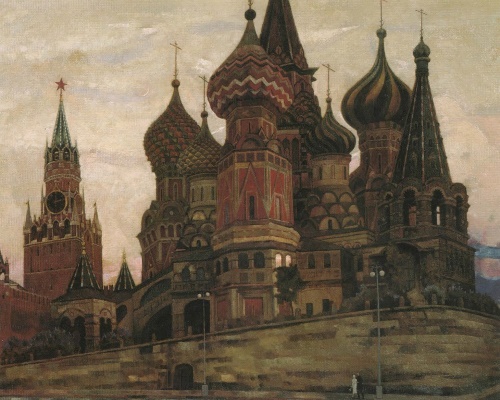
Moscow. Day breaks (St. Basil’s Cathedral after the restoration in 1938). 1987-1988. Property of the artist
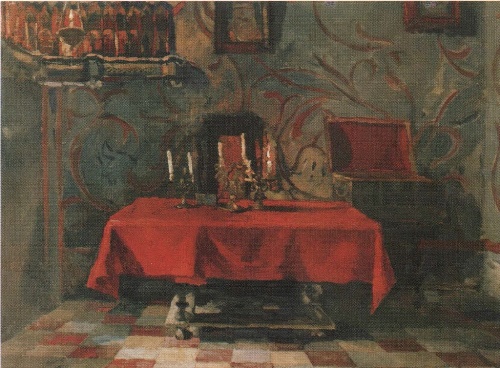
The interior of the cabinet of the Rostov Metropolitan Ion Sysoyevich, the spiritual founder of the ensemble of the Rostov Kremlin. 1951. Rostov-Yaraslavsky architecture-art Museum – Reserve

View of the Kremlin from the roof of the house number 9 on Maroseyka. 1944. The property of the artist
Andrei Gorsky. Illustrated album, 2002
